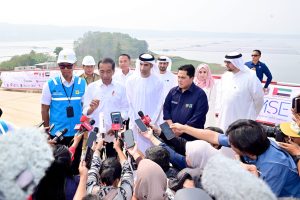In November of last year, Indonesian President Joko “Jokowi” Widodo officially inaugurated the Cirata solar farm in West Java. Built on a reservoir using thousands of floating photovoltaic (PV) panels, the Cirata facility has a generating capacity of 145 MW which makes it the largest floating solar farm in Southeast Asia.
It also represents an important proof of concept which is that Indonesia is, indeed, capable of building new solar capacity at utility scale when it wants to. Despite years of efforts aimed at jump-starting investment in solar, uptake has been incredibly slow. Could Cirata auger a breakthrough and if so, how?
Built at a cost of around IDR 1.7 trillion (a little over $100 million), Cirata is a joint venture between Indonesia’s state-owned electric utility PLN, and a renewable energy firm from the United Arab Emirates called Masdar. Masdar is the minority shareholder, holding 49 percent of the equity. The remaining 51 is held by PLN through a subsidiary.
Masdar is well capitalized – the firm ended 2022 with the equivalent of over $800 million cash on hand – and has powerful backers in the UAE. Masdar’s shareholders are the Abu Dhabi National Oil Company, the Mubadala Investment Company, which is Abu Dhabi’s sovereign wealth fund, and the Abu Dhabi National Energy Company.
Aside from Cirata, Masdar has been very active in Indonesia’s burgeoning renewable energy sector. It took a 47.5 percent stake in Solar Radiance, a joint venture formed with Indonesian coal company PT Mitrabara Adiperdana to produce solar panels. When Indonesia’s state-owned oil and gas giant Pertamina partially listed its geothermal subsidiary on the Indonesia Stock Exchange last year, Masdar acquired a 15 percent stake.
What Masdar seems to understand is that in Indonesia, getting projects fast-tracked and completed is often about finding the right local partners. By partnering with PLN to develop the Cirata solar farm, for instance, Masdar guaranteed that the most powerful player in Indonesia’s electricity sector had a vested interest in seeing the project through to completion. This put Cirata in a better position to overcome the kind of political and economic hurdles that have often derailed renewable energy projects in the past.
Free market purists will likely find this objectionable, as partnering with a subsidiary of a state-owned electric utility to build a power plant that will then sell electricity back to that very same utility goes against much of what we are taught about how markets are supposed to work. However, markets in Indonesia often operate according to their own logic. Understanding and adapting to that logic and the incentive structures it creates, rather than trying to impose the logic of a free market upon it, is key to getting things done.
Masdar’s approach can be usefully contrasted here with that of the Just Energy Transition Partnership (JETP), the proposed $20 billion clean energy fund being spearheaded by the U.S. and its allies. When the JETP released its investment roadmap in November 2023, the same month Cirata was officially inaugurated, the plan called for numerous regulatory reforms that would allow market-based mechanisms like price signals to unleash a big investment boom in solar.
One of the reforms specifically calls for putting an end to private developers cutting PLN in as an equity partner in joint ventures. The argument here is that an electric utility like PLN should play the role of market facilitator and de-risker for private capital, and that when it enters the market as a direct participant it creates distortions.
That might be true, in the abstract. But it’s also true that PLN has less incentive to facilitate and de-risk private investment if it has nothing to gain from it. If the JETP plans to wait around for Indonesia’s energy sector to evolve into an efficient market that is responsive to price signals, and in which PLN plays the role of facilitator rather than participant, the wait might be a long one.
Meanwhile, instead of trying to transform Indonesia into a type of efficient market that it has never historically been, Masdar is already in the country building utility-scale solar and manufacturing solar PV panels. And it is doing so by entering into joint ventures and investment partnerships with Indonesian stakeholders that can make things happen quickly, like Pertamina and PLN.
Is that the right or best option to accelerate renewable energy development in all cases? I don’t know. But I do know that if Indonesia is to hit its ambitious emission reduction targets, we should keep an open mind and consider all options. That includes counterintuitive arrangements that may go against mainstream economic logic, like cutting PLN in as an equity partner in solar farms or creating a joint venture with a coal company to manufacture solar panels.

































